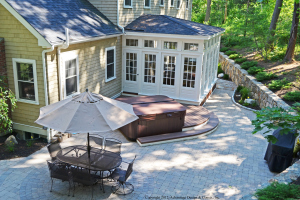Working at Archadeck Outdoor Living, I’ve seen some beautiful patios, walkways, outdoor kitchens, outdoor fireplaces and other hardscaped areas over the years that our offices have designed and built. The beauty of the finished product can be misleading however. At its surface, the patio looks gorgeous, but what lies below is what keeps it looking that way in the long run.
Building a patio that will hold its shape and structure is more difficult than the looks of it show.
The first step is to prepare the ground for the patio. This includes grading and digging footings. Grading is the process of leveling the ground. If the ground isn’t properly graded, it will lead to an uneven outdoor living space. Grading may include removing or adding more dirt to the space and packing it down until it is firm and even.

If the patio is a simple patio, footings may not be required while preparing for the build, but if you are adding something with extra weight, like an outdoor kitchen or outdoor fireplace, footings need to be created. Footings are essentially bases for extra large structures. For this example, let’s use an outdoor fireplace. Due to its weight, it needs more support from below. A large hole is dug underneath where the fireplace will ultimately sit. That hole is filled with concrete that, when hard, will be able to hold up the outdoor fireplace for years to come.
After the footings are dug and the ground is leveled, the layers begin. The first layer that is placed on the ground is called base stone. Base stone is key to keeping the patio level over time and seasonal changes. Once the stone is laid in place, it is then impacted down. Like the dirt below it, the base stone will be leveled.
After the base is all set and in place, sand is spread and leveled on top of it. Sand is a helpful as the pavers are placed down on top of it as it helps to keep it all in place before everything is locked in tightly.
Laying pavers can be as simple or as complex as you’d like. It just depends on how intricate you want the design of it to be. At Archadeck, we’ve done some that are simple rows and others with circular or curved patterns.
 Once everything is in place, it has to be secured. Along the sides of the patio, there will be an edging materials that digs into the ground. It works as a barrier for the pavers. The most common way to lock your paver patio in place is to use polymeric sand. This sand is spread and swept on the surface of the patio, working it’s way into all the nooks and crannies of the entire space. Then it will be exposed to water. When it gets wet, the sand will harden, similar to concrete.
Once everything is in place, it has to be secured. Along the sides of the patio, there will be an edging materials that digs into the ground. It works as a barrier for the pavers. The most common way to lock your paver patio in place is to use polymeric sand. This sand is spread and swept on the surface of the patio, working it’s way into all the nooks and crannies of the entire space. Then it will be exposed to water. When it gets wet, the sand will harden, similar to concrete.
As you can see, building a patio is much more difficult than simply picking out a stone that you like. At Archadeck, we take great pride in our work and take the time to do it all correctly so you can enjoy the space for years to come.
If you have any questions on designing or building custom patios, please contact your local Archadeck office.